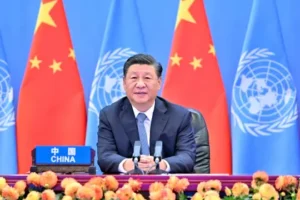Shared Future and Sustainable Development Goals (SDGs)
Building a Shared Future Through SDGs
Human civilisation has proved to be the turning point of the twenty-first century. For the first time in history, common struggles and goals are being shared by the nations. The world leaders agreed on the 2030 Agenda for Sustainable Development in 2015 as a collaborative roadmap for peace, prosperity, and planetary balance. The agenda was established with 17 Sustainable Development Goals (SDGs).
The SDGs reflect mankind’s attempt to cooperate across borders, just as the United Nations’ establishment in 1945 changed the post-war world order. This proved that the development and advancement of a nation can only be fulfilled with a core vision to uplift humanity together.
The SDGs’ Vision and Promise
The SDGs provide a comprehensive approach to development that balances social justice, ecological sustainability, and economic prosperity. They highlight hunger, education, poverty, gender equality, climate action, and peace as the foundations of human prosperity.
Global extreme poverty has decreased to 8.5% from over 35% in 1990, according to The Sustainable Development Goals Report 2024. Electricity is now available to more than 91% of the world’s population. Since 2000, child mortality rates have decreased by more than 50%. These achievements demonstrate that group efforts can produce noticeable outcomes when motivated by a common goal.
But there are still many challenges to overcome. According to the same UN assessment, only 15% of the SDG targets are currently on track. The pace of progress in reducing hunger, combating climate change, and protecting biodiversity has slowed or even reversed. The idea of shared prosperity won’t be fully realised without fresh cooperation and international investment.
Difficulties for Our Shared Future
The global community’s resilience has been tested over the past 10 years since the SDGs were adopted. The world is facing a major issue, such as climate change, right now. According to the World Meteorological Organisation (WMO), the past ten years have been the hottest on record, with over $400 billion in weather-related damages in 2023 alone. Today, hundreds of millions of people’s homes are at risk due to the rapid rise in sea levels.
Inequality keeps growing at the same time. The richest 10 percent of people hold almost 75 percent of the world’s wealth. On the other hand, the poorest half own only 2 percent, according to the World Inequality Database 2024.
Both displacement and conflict have escalated to previously unheard-of levels. According to the UN Refugee Agency (UNHCR), over 110 million people are forcibly displaced globally, which is the largest number in modern history.
According to UNESCO’s Global Education Monitoring Report 2024, the COVID-19 epidemic increased these disparities by forcing 120 million people back into poverty.
Restoring Global Solidarity and Multilateralism
Multilateral collaboration must be renewed in order to realise the vision of a shared future. “Networked multilateralism,” which links governments, the commercial sector, and civil society in cooperative problem-solving, has been advocated by Secretary-General António Guterres.
The Organisation for Economic Co-operation and Development (OECD) estimates that $3 to $5 trillion will be needed annually to achieve the SDGs. But the current global financing is around $2 trillion short of that amount. Fairness and trust are the only pillars upon which shared prosperity can flourish.
The Road to 2030 and Beyond
The whole world has a limited window for change, with only five years left till 2030. The upcoming years must be guided by three priorities:
- Reform Global Systems: Update international organisations to provide equal access to commerce and finance, fair representation, and open governance.
- Encourage Local Innovation: Help local leaders, educators, and cities in converting international objectives into local realities.
- Utilize Ethical Technology: As stated in the UN Global Digital Compact 2024, biotechnology, green energy, and artificial intelligence must align with human values.
According to the UN Summit of the Future 2024, despite geopolitical differences, multilateralism is still the most effective source of maintaining peace, protecting the environment, and achieving the SDGs.
Conclusion
The Sustainable Development Goals are not just a checklist to follow; they are humanity’s moral compass. They remind us that growth must be environmentally friendly, peace must be just, and progress must be inclusive.
If countries choose cooperation over force and peace over indifference, the common future envisioned in 2015 with a world of opportunities and equal life values, where humanity can prosper well. Humanity has a clear choice: either progress forward as a group or withdraw into solitude. The collaboration and courage we show now will determine our shared future.


